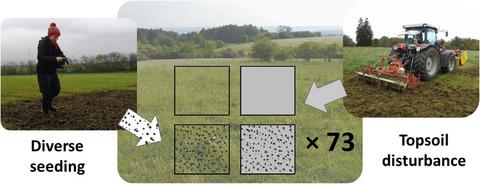当前位置:
X-MOL 学术
›
J. Appl. Ecol.
›
论文详情
Our official English website, www.x-mol.net, welcomes your
feedback! (Note: you will need to create a separate account there.)
Restoration of plant diversity in permanent grassland by seeding: Assessing the limiting factors along land-use gradients
Journal of Applied Ecology ( IF 5.0 ) Pub Date : 2021-04-18 , DOI: 10.1111/1365-2664.13883 Martin Freitag 1 , Valentin H. Klaus 2 , Ralph Bolliger 3 , Ute Hamer 1 , Till Kleinebecker 4 , Daniel Prati 3 , Deborah Schäfer 5 , Norbert Hölzel 1
中文翻译:

通过播种恢复永久性草地植物多样性:评估沿土地利用梯度的限制因素
更新日期:2021-04-18
Journal of Applied Ecology ( IF 5.0 ) Pub Date : 2021-04-18 , DOI: 10.1111/1365-2664.13883 Martin Freitag 1 , Valentin H. Klaus 2 , Ralph Bolliger 3 , Ute Hamer 1 , Till Kleinebecker 4 , Daniel Prati 3 , Deborah Schäfer 5 , Norbert Hölzel 1
Affiliation

|
- Land-use intensification has caused dramatic declines in grassland biodiversity, and in Europe this decline has not yet been halted. Therefore, a major challenge in ecological restoration is to effectively restore plant diversity in permanent grasslands, that is, long-term managed grassland not being used as cropland. As species richness is often limited by seed dispersal, introducing locally absent species is crucial. Seeding diverse seed mixtures is an appropriate tool, but restoration outcomes are highly variable. Considering constraints by land-use intensity and plant functional traits during restoration could improve the efficacy of restoration efforts.
- We established a full-factorial experiment with high-diversity seeding and topsoil disturbance in 73 grasslands along land-use intensity and productivity gradients and evaluated the restoration success over 5 years. In addition, after 5 years we assessed the number of established species and tested whether specific traits promoted the establishment of sown species in interaction with productivity.
- Plant diversity increased considerably when seeding and disturbance were combined while seeding alone only slightly increased species richness. Along land-use gradients, we found no direct effects of grazing or mowing on the establishment of sown species, but fertilization indirectly limited establishment in the combined treatment via a negative effect of productivity.
- Functional traits structured the establishment of sown species, especially in the combined treatments, but effects varied with productivity. Species with low seed mass and low specific leaf area had greater establishment success in low-productivity grasslands, whereas species with high seed mass had greater establishment in high-productivity grasslands.
- Synthesis and applications. Our results highlight the potential of using diverse seed mixtures for biodiversity restoration in a wide range of permanent grasslands, especially when combined with topsoil disturbance. However, productivity both limited restoration success and affected establishment via an interaction with plant functional traits. As productivity is a major constraint in grassland restoration, we strongly recommend to first stop fertilization and reduce soil nutrient loads in highly productive grasslands. Restoration by seeding, with or without disturbance, should only be applied when productivity is reduced and the local environment should be considered to compile site-specific seed mixtures to maximize restoration success.
中文翻译:

通过播种恢复永久性草地植物多样性:评估沿土地利用梯度的限制因素
- 土地利用集约化导致草地生物多样性急剧下降,而在欧洲,这种下降尚未停止。因此,生态恢复的一个主要挑战是有效恢复永久性草地的植物多样性,即长期管理的草地不被用作农田。由于物种丰富度通常受到种子传播的限制,因此引入当地缺乏的物种至关重要。播种不同的种子混合物是一种合适的工具,但恢复结果变化很大。在恢复过程中考虑土地利用强度和植物功能特性的限制可以提高恢复工作的效率。
- 我们在 73 个草地沿土地利用强度和生产力梯度建立了高多样性播种和表土扰动的全因子试验,并评估了 5 年的恢复成功率。此外,5 年后,我们评估了已建立物种的数量,并测试了特定性状是否促进了与生产力相互作用的播种物种的建立。
- 当播种和干扰相结合时,植物多样性显着增加,而单独播种仅略微增加物种丰富度。沿着土地利用梯度,我们发现放牧或割草对播种物种的建立没有直接影响,但施肥通过生产力的负面影响间接限制了联合处理中的建立。
- 功能性状构成了播种物种的建立,尤其是在组合处理中,但效果因生产力而异。种子质量低和比叶面积低的物种在低生产力草地上的定殖成功率更高,而种子质量高的物种在高生产力草原上定殖的成功率更高。
- 合成与应用。我们的研究结果突出了使用多种种子混合物在广泛的永久性草原中恢复生物多样性的潜力,尤其是在与表土干扰相结合时。然而,生产力既限制了恢复成功,又通过与植物功能性状的相互作用影响了建立。由于生产力是草地恢复的主要制约因素,我们强烈建议首先停止施肥并减少高生产力草地的土壤养分负荷。通过播种进行恢复,无论有无干扰,都应仅在生产力降低时进行,并且应考虑当地环境以编制特定地点的种子混合物,以最大限度地提高恢复成功率。











































 京公网安备 11010802027423号
京公网安备 11010802027423号